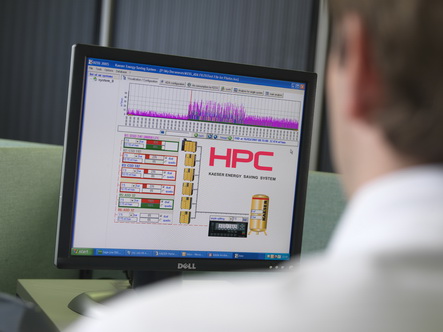Philip McArragher, technical manager for HPC Compressed Air Systems, explains that efficient compressed air systems have to be carefully planned and designed. However, energy and cost conscious planning and implementation is just half the story. Only efficient compressed air system operation ensures cost effective compressed air production over the long term.
Striving for maximum system efficiency brings triple savings: air system reliability increases, whilst air costs and power consumption significantly decrease. The EU “SAVE II” study showed the extent of the potential savings that can be achieved: Compressors in the EU consumed 80 billion kWh in the year 2000 - at least 30 % of this energy could have been saved.
What does optimum efficiency mean?
The efficiency of a compressed air system is reflected by its cost structure. The achievable optimum is never the same because it is related to a specific company and its production. Critical factors are compressors operating life, working pressure and other commercial parameters. Even under optimum conditions the power consumption of a compressor can account for 70 to 80 percent of the overall compressed air costs.
How to Maintain Operating Efficiency
In order to maintain the long-term efficiency of a compressed air system there are several key areas that should be carefully considered and addressed:
- Demand Orientated Servicing - Advanced internal compressor controllers and compressed air management systems provide accurate information on service intervals for the components of an air system. This has made it possible to carry out preventative maintenance and demand-orientated service work. This results in lower maintenance costs, as well as increased efficiency and reliability.
- Matching Air Consumers - It is a false economy to make savings for compressed air production and consumption i.e. to use a cheaply priced production machine that requires a higher working pressure. The cost of generating pressure higher than the standard 6 bar would quickly rise above the extra cost for a more efficient machine working with a lower pressure. When considering the specification of new air consuming production machines the pressure of the air needed is just as important as the electrical power supply, which is why guidelines should be written for the purchase of such production machines that cover both electrical power and compressed air supplies.
- New Production Related Requirements - Changes in air consumption can often have a considerable impact on system efficiency and the optimisation of operating costs.
Modification of Production
In most manufacturing facilities the compressed air demand varies from shift to shift. This is often ignored and it can happen that after a change in production by the introduction of a new process, for example, the compressors in one shift are suddenly running far below capacity whereas in the other not even the reserve capacity is sufficient to cover the demand. The air supply should provide the flexibility to meet such changes.
Expansion in Production
In this case not only the compressor capacity but also the pipework and the air treatment equipment may have to be adapted to meet the increased demand. It is advisable to precisely measure and document the air consumption of the existing compressor system.
Air Supply Reliability
It is usual to include a standby compressor in an air system to provide coverage when another is being serviced or replaced and to provide for occasional demand peaks. Such a reserve capacity, however, should be matched by reserve capacity in the air treatment equipment. When air consumption rises, the standby compressor cuts in, but because of the lack of additional air treatment capacity the compressed air quality deteriorates as a result. The air treatment system should be designed to cope when all available compressors are running.
Changing The Air Quality
If better air quality is needed the procedure differs depending on whether all the production is affected or only one section. In the former case, it is not enough to simply re-equip the central compressed air pipework. The pipework that has transported air of lower quality, will have to be cleaned or renewed. In the latter case, local air treatment that can supply the quality required is recommended. Air-flow through local treatment devices should be limited. This ensures that an increase in demand above that for which the devices are intended does not result in degradation of air quality.
Monitoring Leaks
Leakages occur in every air network whether it is well maintained or not, and they have the tendency to increase. This can lead to considerable energy losses. The main cause is wear on hose connectors and machine components. This is why it is vital to keep track of such problems and take prompt action whenever they occur. It is advisable to regularly measure overall leakage with the aid of modern control and monitoring systems.
Cost Management Ensures Efficiency
Information acquired by analysis during the planning stage is also relevant for future system operation. Once the system is installed and running, however, no special analysis is needed to acquire data at a later stage. These tasks are taken over by advanced master controllers. This forms the basis for online compressed air audits and effective cost-management of the compressed air system. The more users introduce transparency into their air cost structure, search out potential savings and give priority to energy efficiency rather than price when purchasing air supply equipment, the nearer we will get to achieving the calculated 30 % energy-saving potential. That’s not only good for the balance sheet but also benefits the environment.
For further information please visit: www.hpccompressors.co.uk






